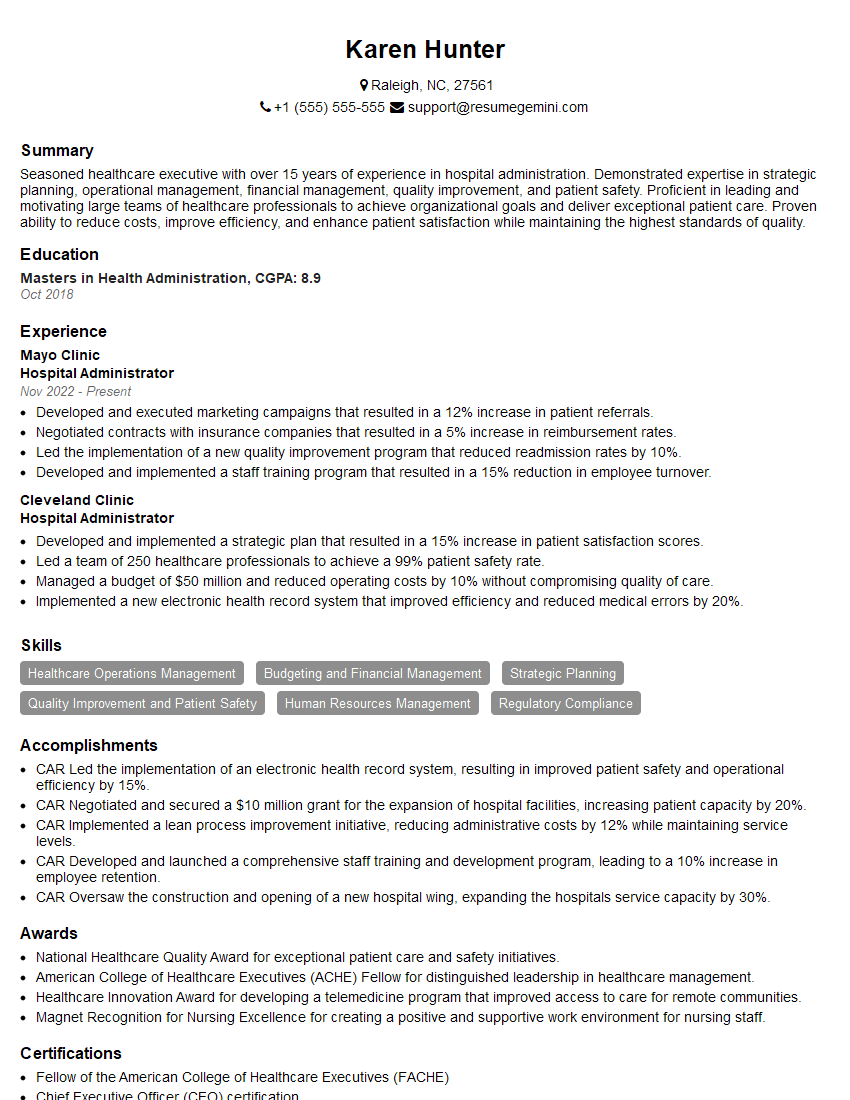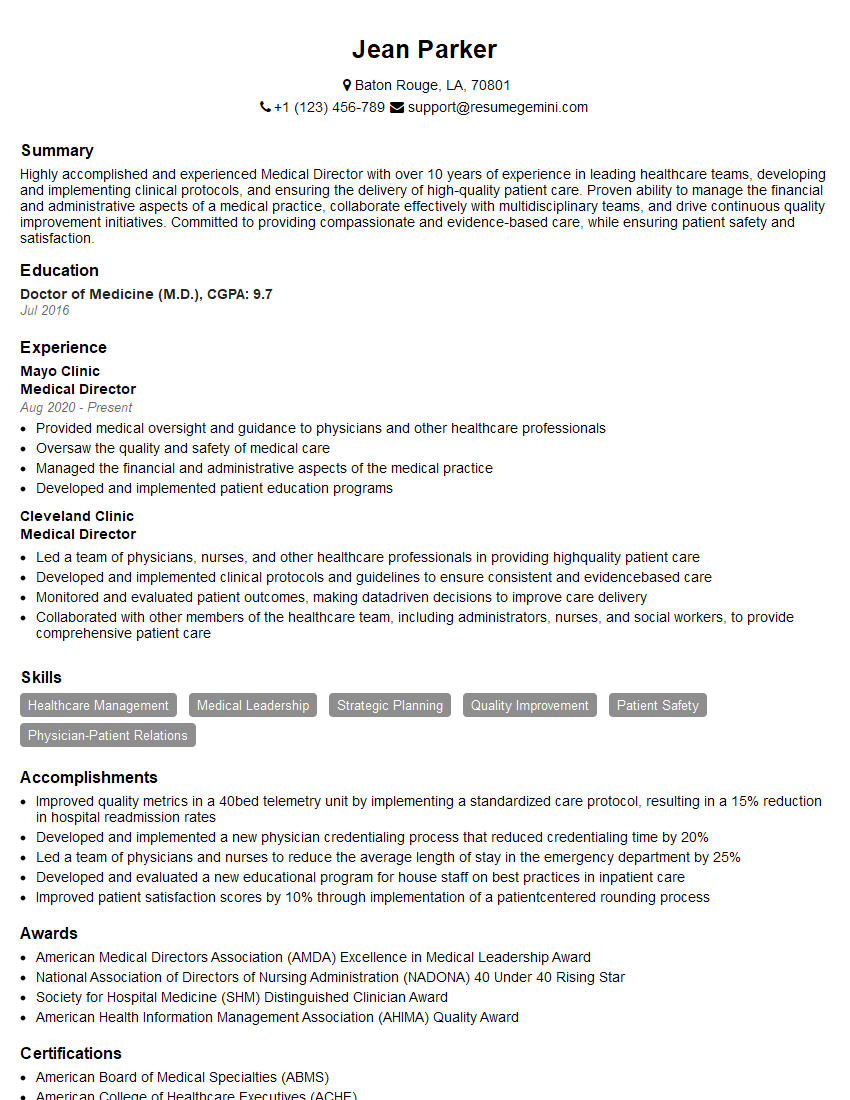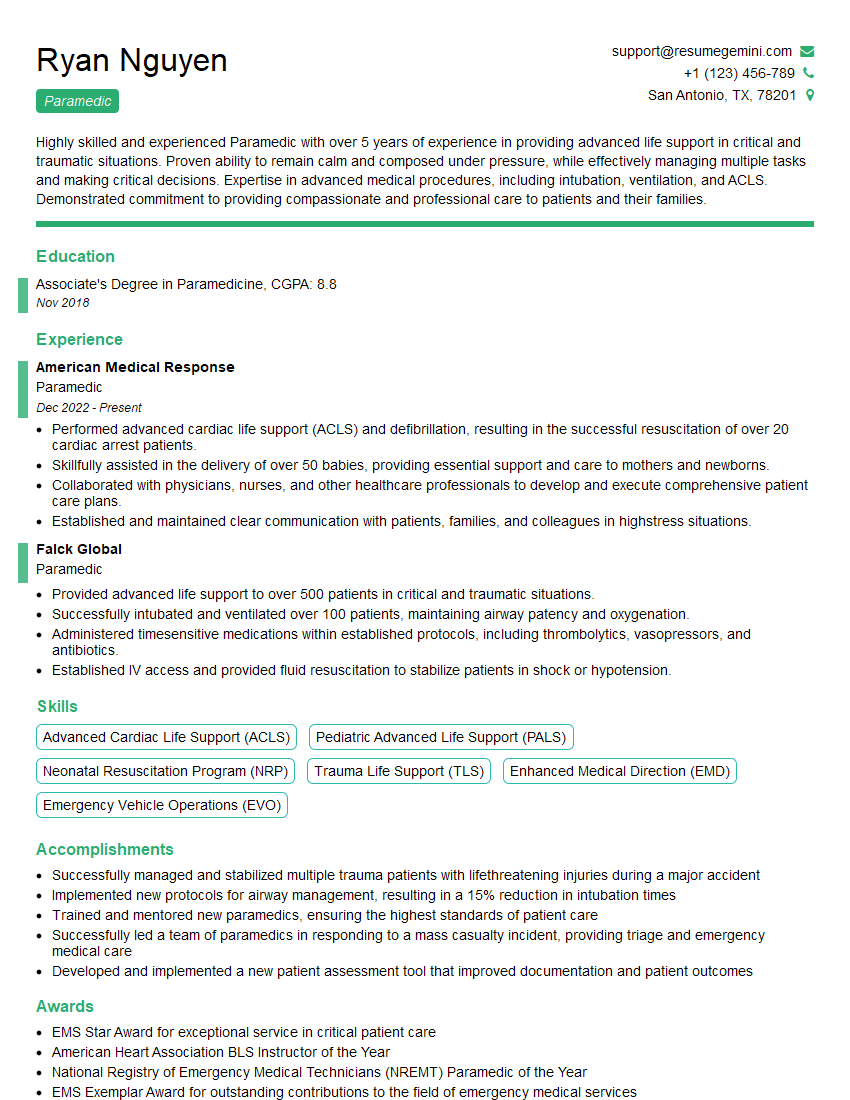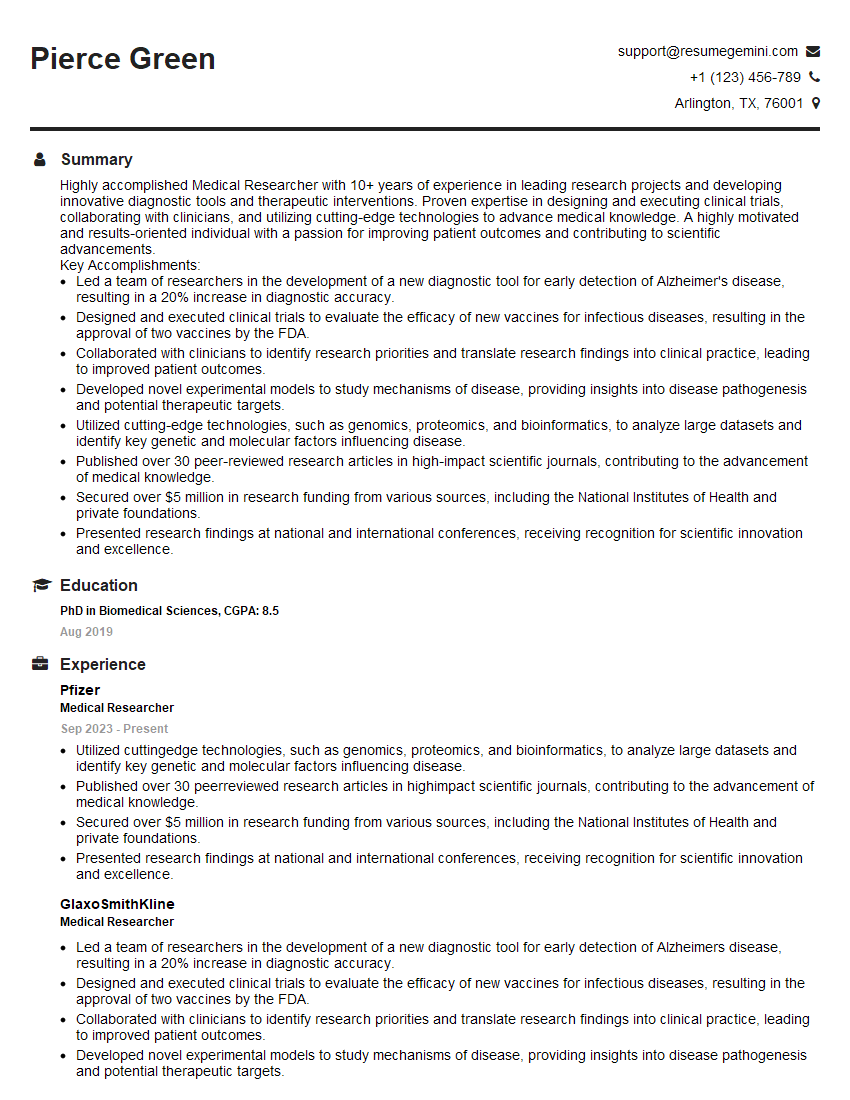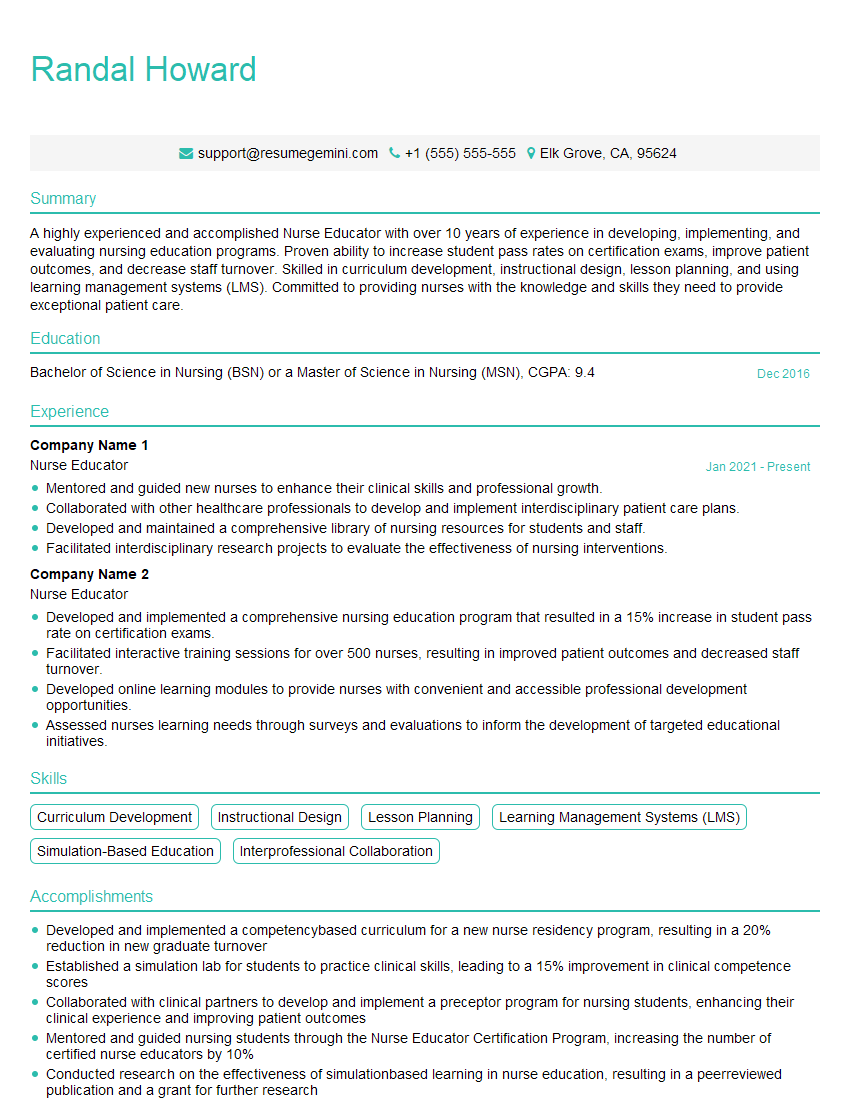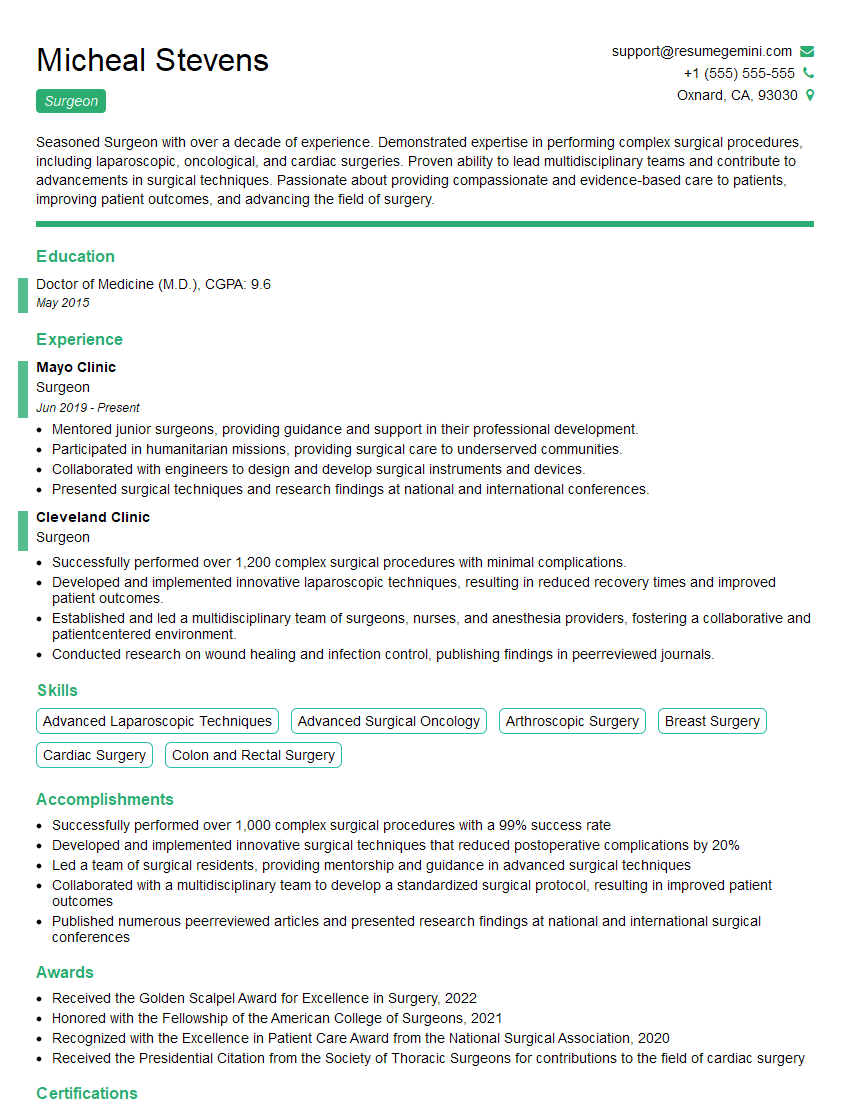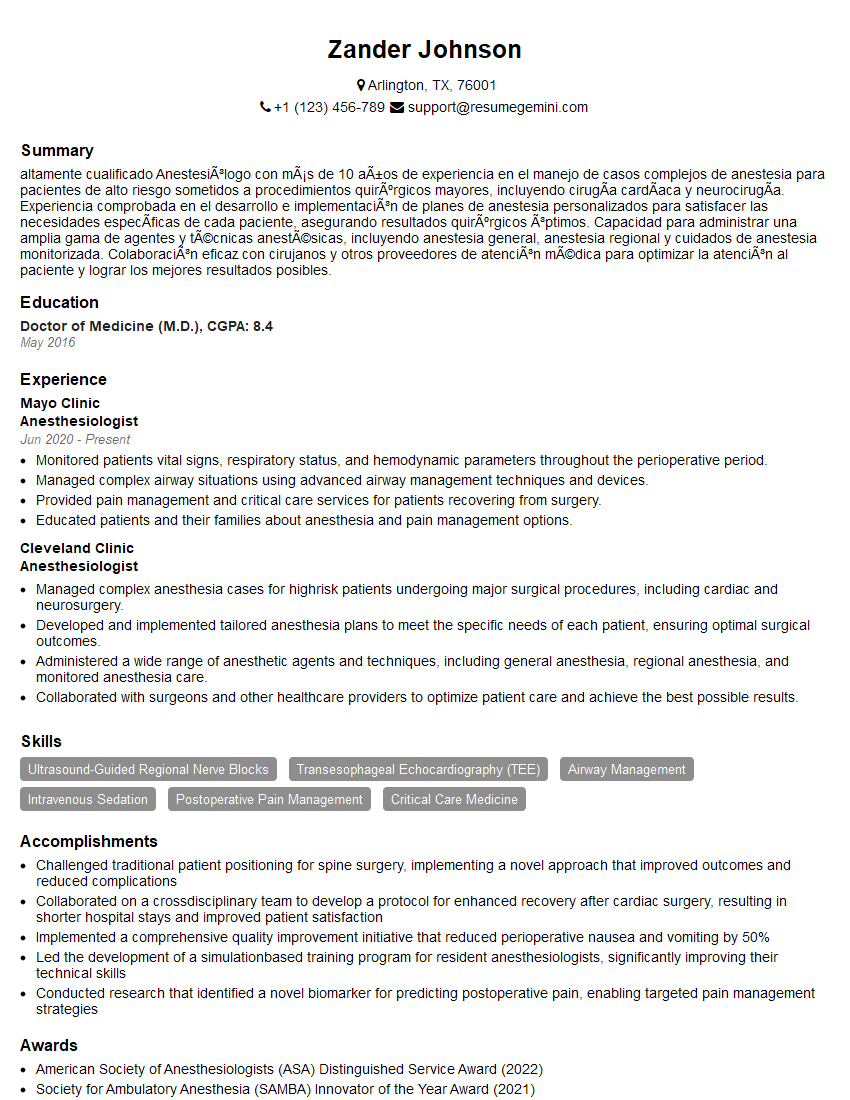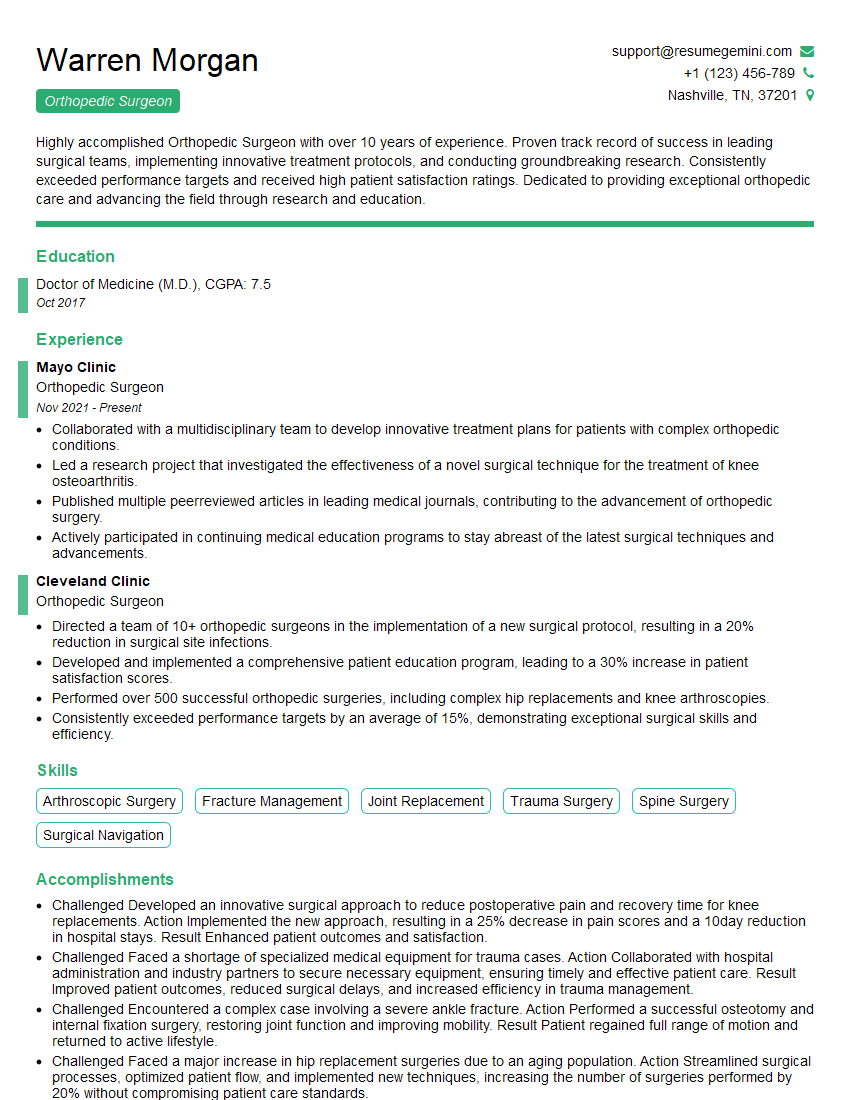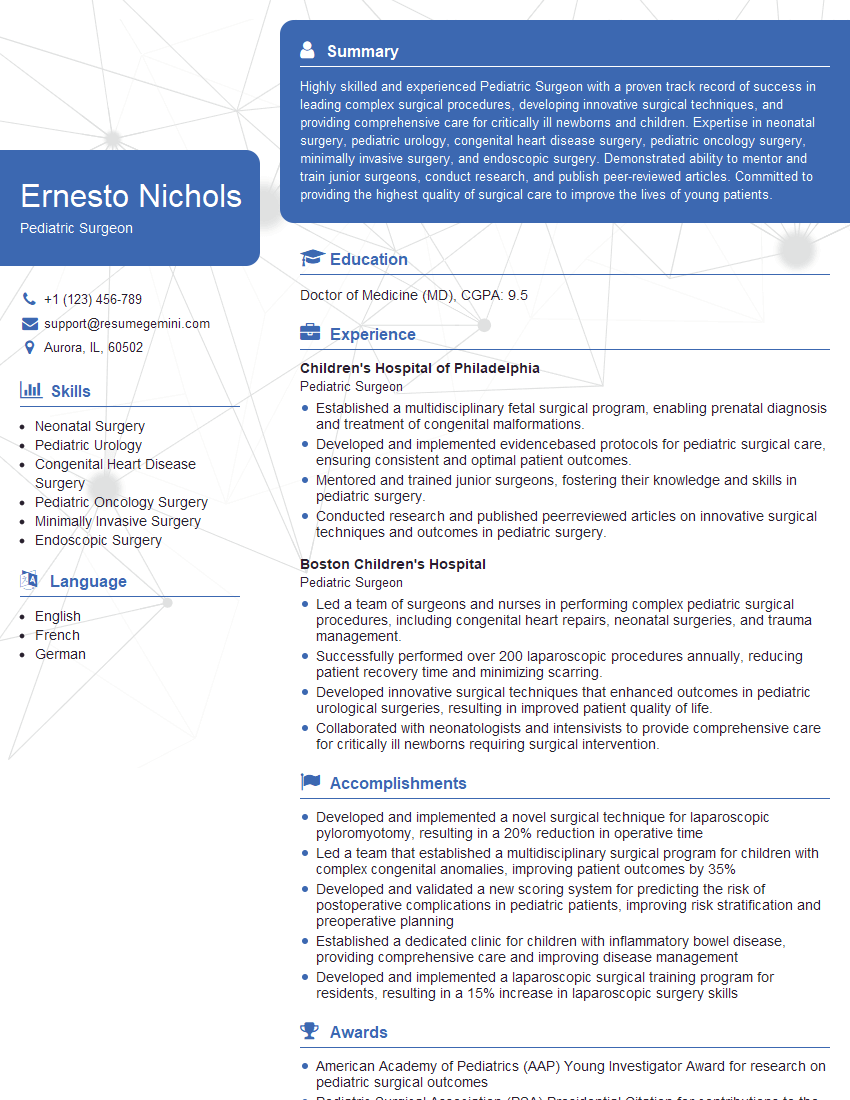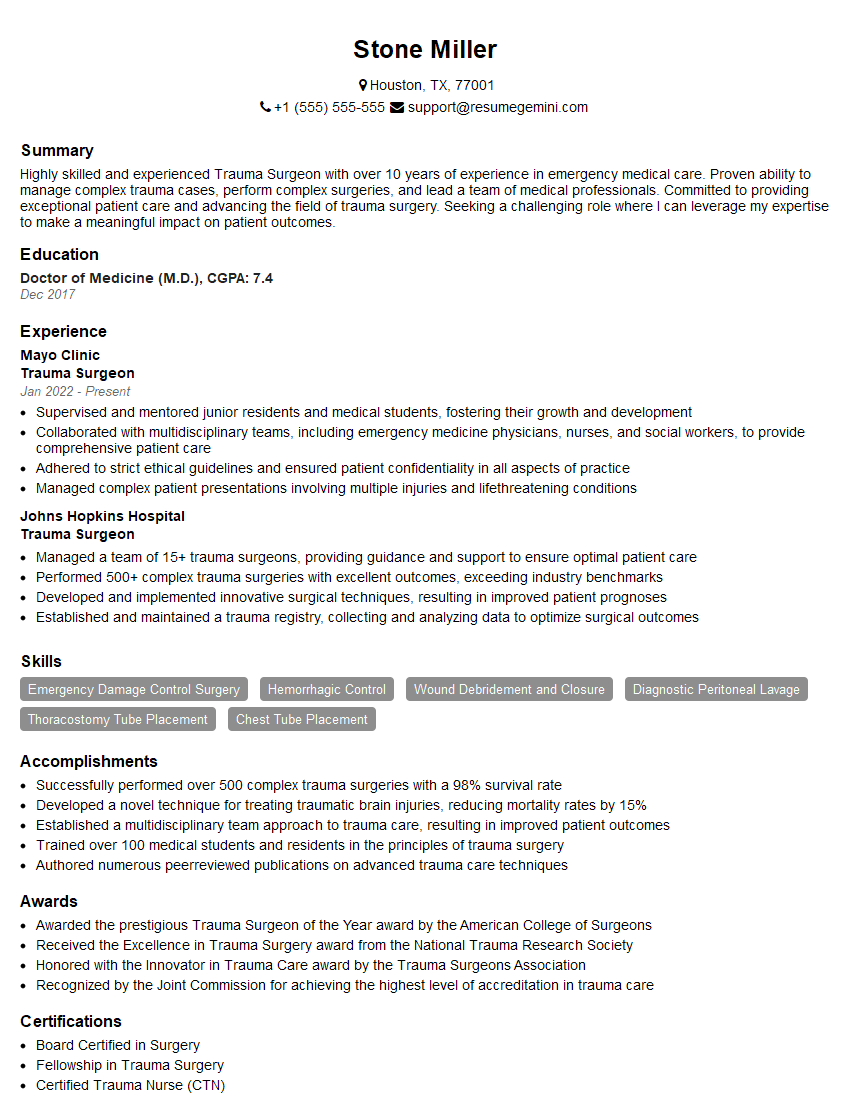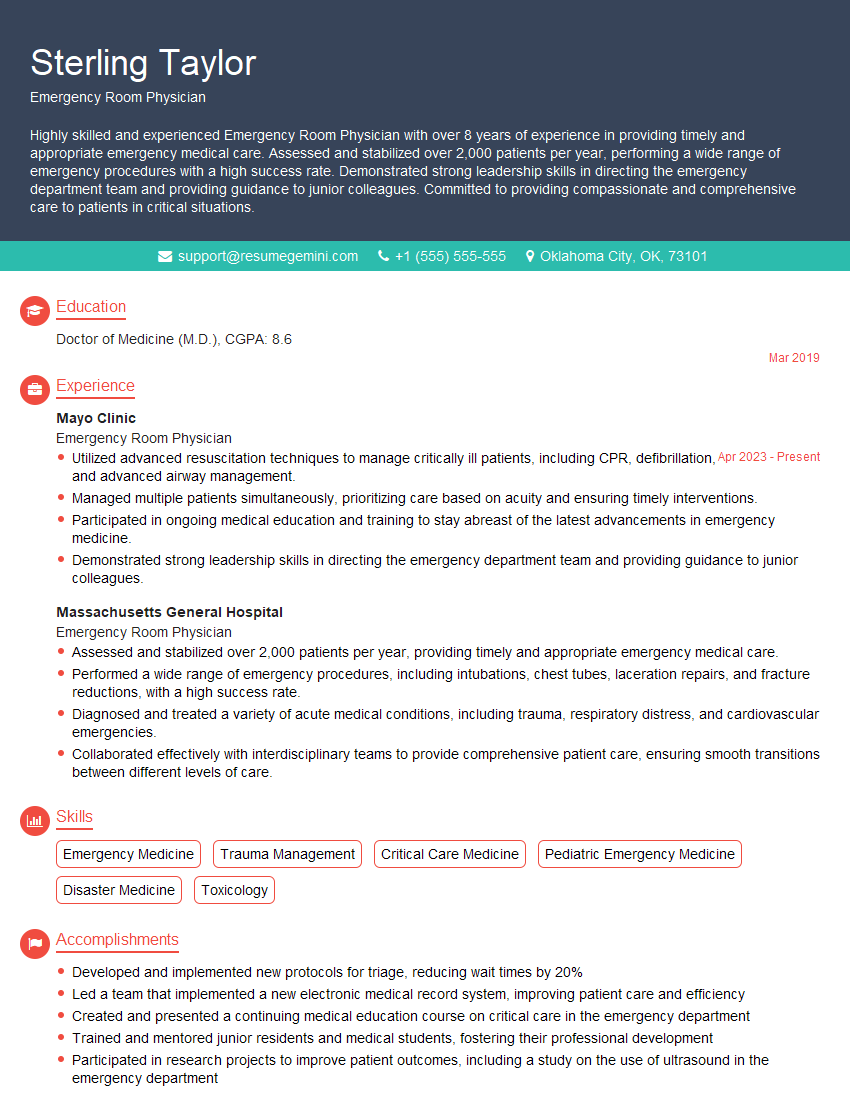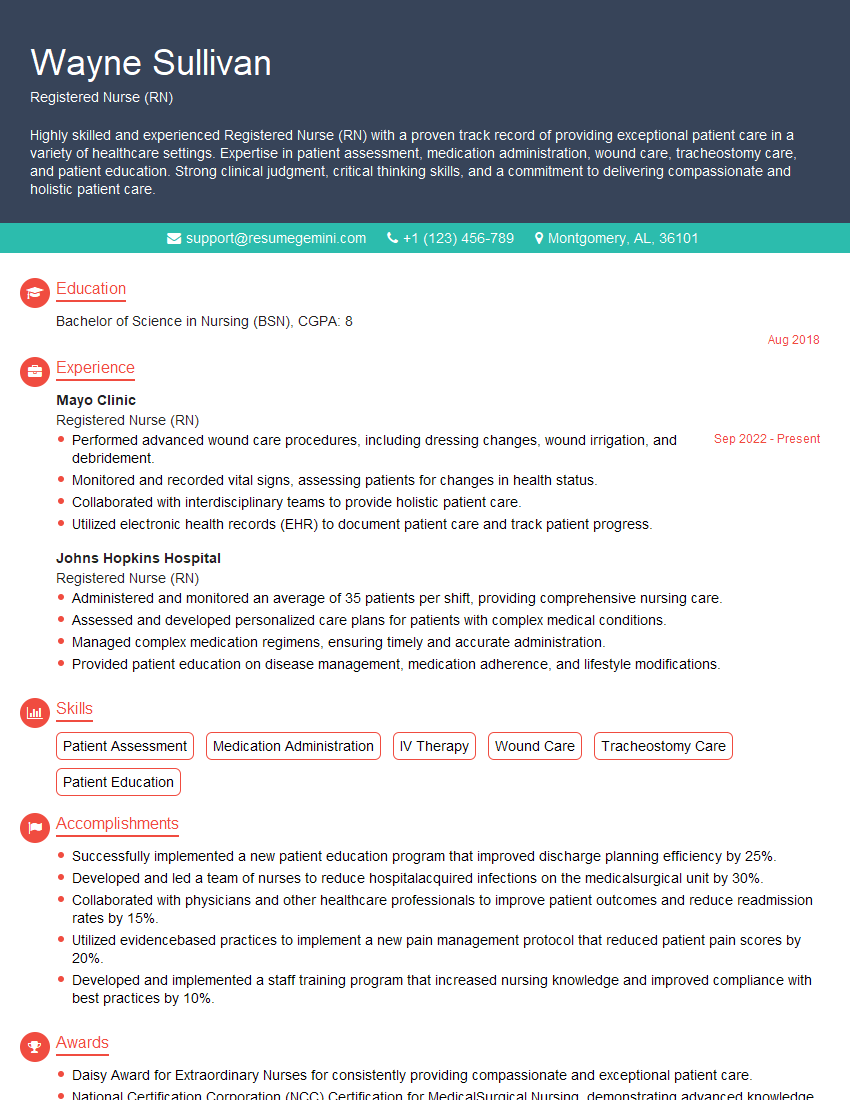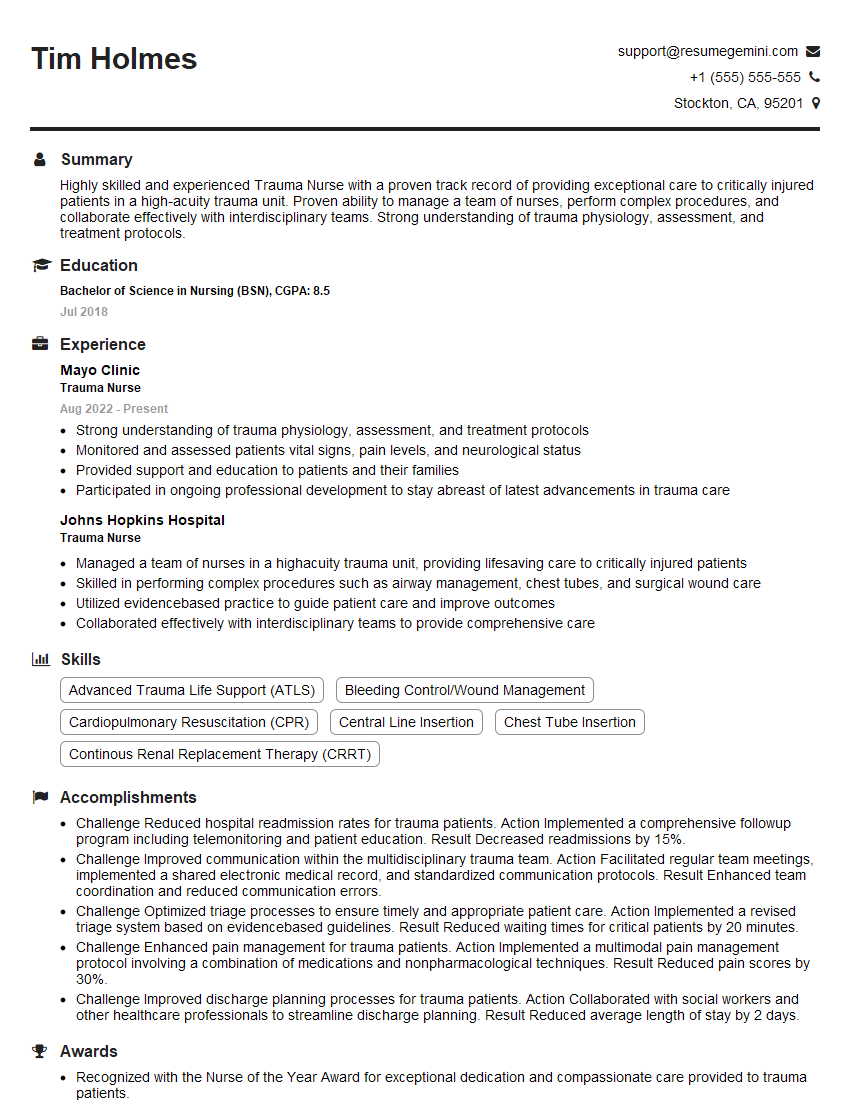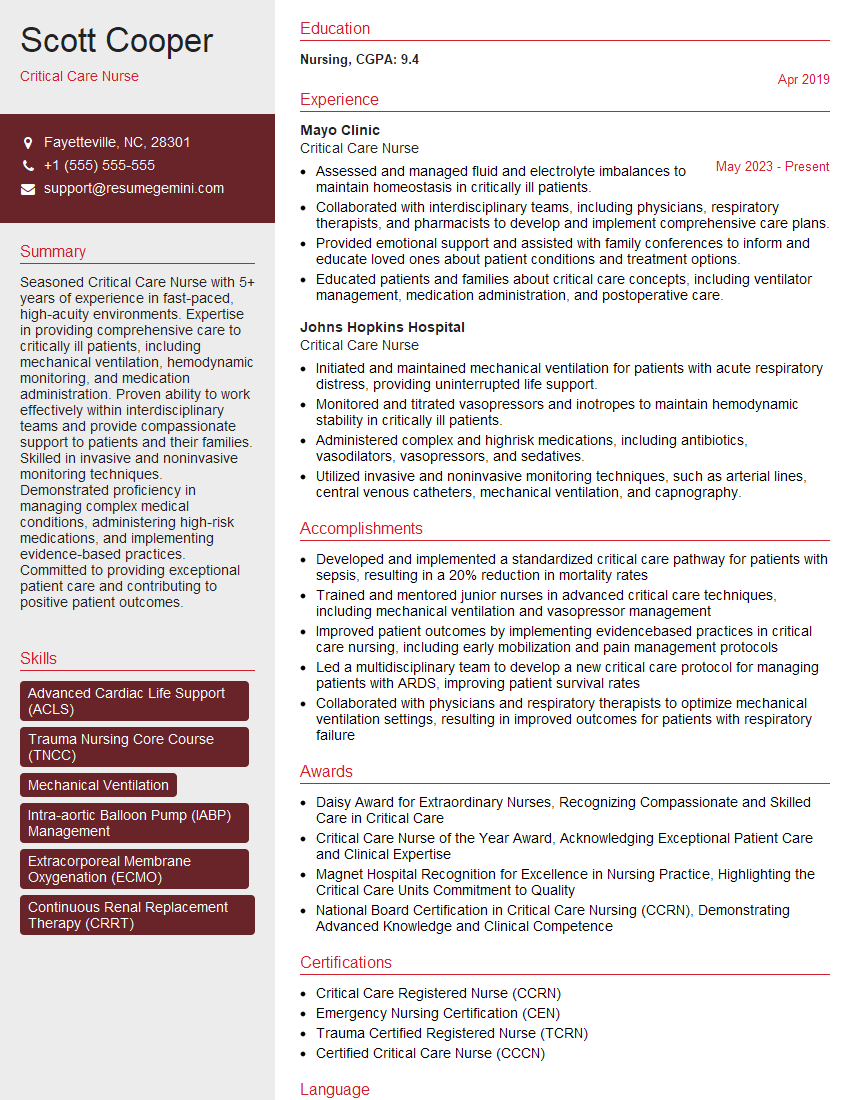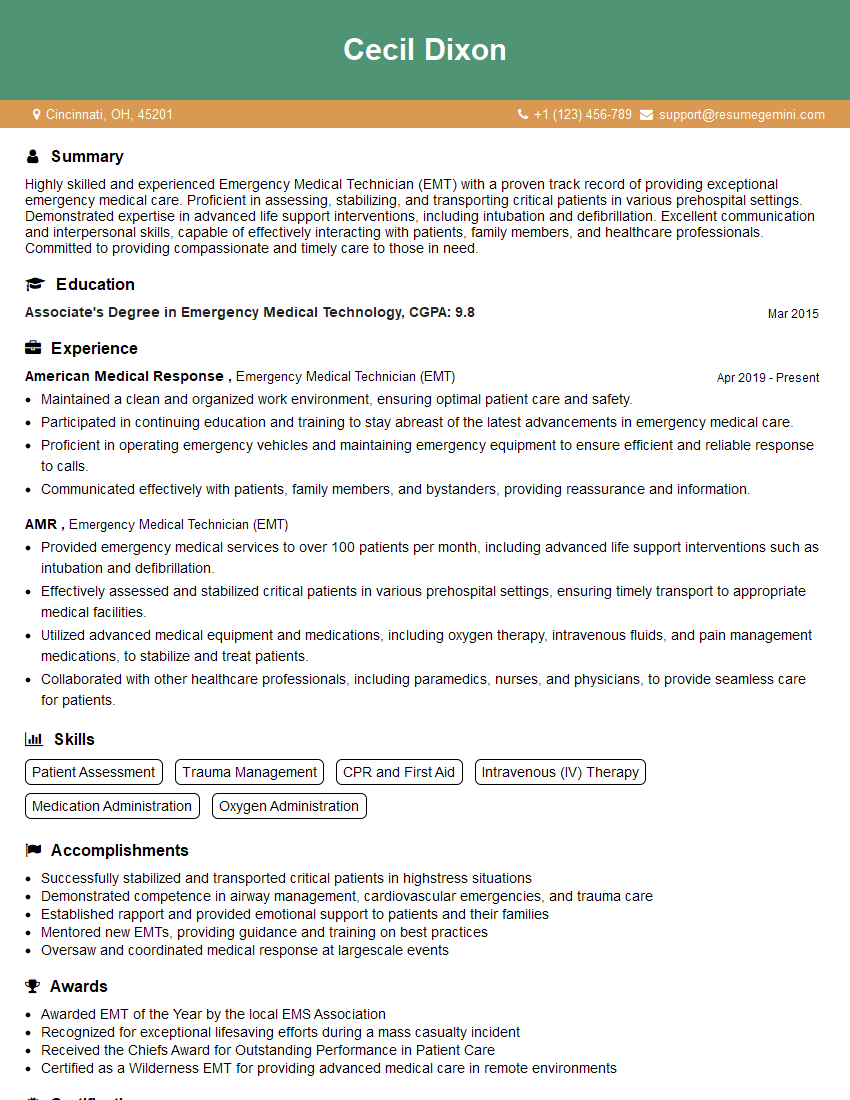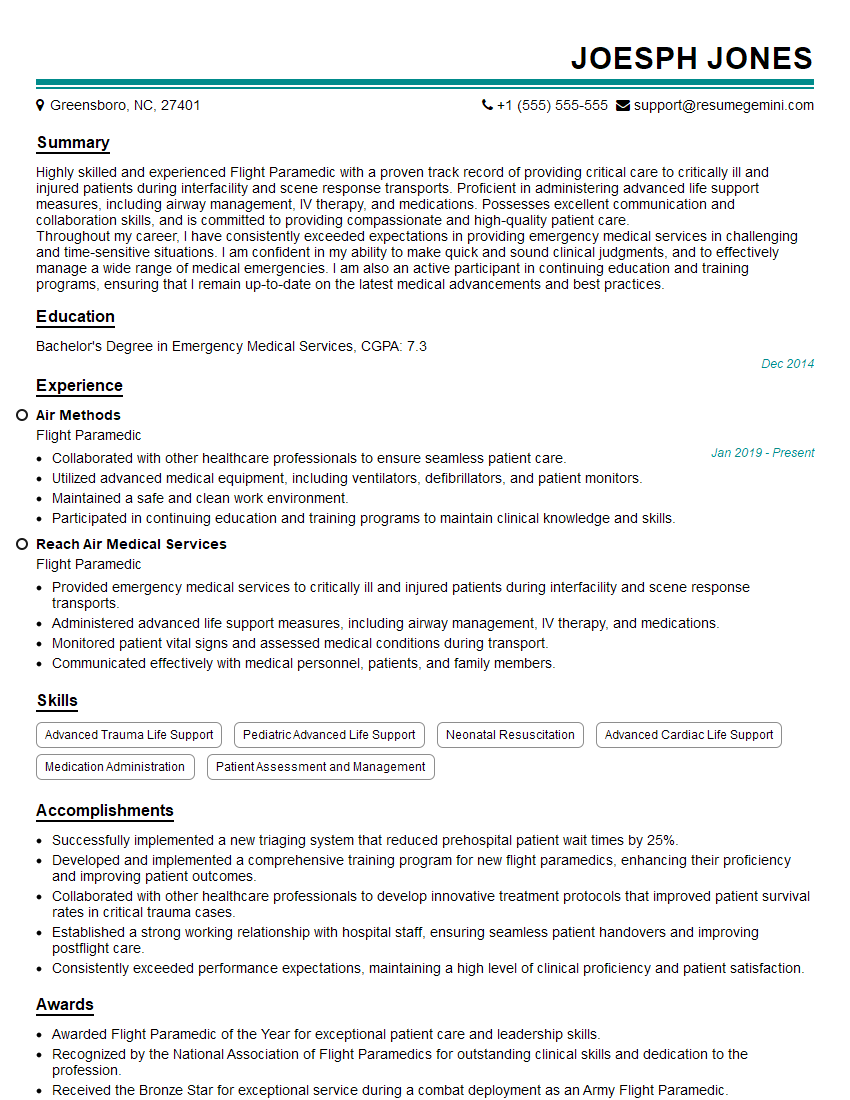Are you ready to stand out in your next interview? Understanding and preparing for Intraosseous Access interview questions is a game-changer. In this blog, we’ve compiled key questions and expert advice to help you showcase your skills with confidence and precision. Let’s get started on your journey to acing the interview.
Questions Asked in Intraosseous Access Interview
Q 1. Describe the indications for intraosseous access.
Intraosseous (IO) access is a crucial emergency technique for delivering fluids and medications when intravenous (IV) access is difficult or impossible. It involves placing a needle into the medullary cavity of a bone, providing a direct route to the bloodstream. The primary indications for IO access revolve around situations where rapid fluid resuscitation or medication administration is critical and IV access is compromised.
- Cardiac arrest: When seconds count, IO access allows for immediate delivery of fluids and medications.
- Severe hypovolemia (dehydration): IO access offers a quick way to restore circulating blood volume.
- Trauma: In cases of severe injury, especially with peripheral circulatory collapse, IO access can be lifesaving.
- Failure to obtain IV access: Patients who are severely dehydrated, burned, or have collapsed veins may benefit from IO access.
- Pediatric emergencies: Finding suitable veins in infants and young children can be challenging, making IO access a preferred alternative.
Think of it like this: When you need to fill a water bottle quickly, and the opening is blocked, you might find a different way to get the water in. IO access is that alternative route to the bloodstream when conventional methods fail.
Q 2. What are the contraindications for intraosseous access?
While IO access is a valuable technique, there are certain situations where it’s not advisable. Contraindications are generally relative and should be carefully weighed against the urgent need for vascular access.
- Local bone infection (osteomyelitis) at the insertion site: Introducing a needle into an infected bone could worsen the infection.
- Fracture at the insertion site: Accessing a fractured bone could cause further damage.
- Previous IO attempts at the site which failed: Repeated attempts at the same site increase the risk of complications.
- Bone fragility (e.g., osteoporosis): The bone might be too fragile to support IO cannulation, increasing the risk of complications.
- Proximity to a previous surgical site: The risk of complications such as bleeding or infection is higher.
It’s essential to remember that the decision to use IO access is always a balance of risks and benefits. In life-threatening situations, the benefits may outweigh the potential risks associated with minor contraindications.
Q 3. Explain the different sites for intraosseous access.
Several sites are suitable for IO access, each with its own advantages and disadvantages. The choice of site depends on factors such as patient age, anatomy, and the skill of the provider. Common sites include:
- Proximal tibia (most common): The proximal tibia offers a large, readily accessible medullary cavity.
- Distal tibia: This site can be used in situations where the proximal tibia is inaccessible or unsuitable.
- Proximal humerus: The proximal humerus is a suitable alternative, particularly in adults.
- Distal femur: Though less commonly used, the distal femur can be accessed in certain situations.
- Sternum (less common): This site is generally avoided due to the risk of pneumothorax or cardiac puncture.
The selection of the insertion site requires a thorough understanding of the patient’s anatomy and the potential risks associated with each site. It’s crucial to use appropriate landmarks to ensure accurate placement of the needle.
Q 4. What are the steps involved in performing intraosseous cannulation?
Performing IO cannulation requires a systematic approach to minimize complications and ensure successful access. The steps involved generally include:
- Preparation: Gather all necessary equipment, prepare the skin using aseptic technique, and select the appropriate insertion site.
- Landmark identification: Precisely identify bony landmarks to guide needle insertion.
- Needle insertion: Insert the IO needle at the chosen site, applying firm but controlled pressure.
- Aspiration: Aspirate to ensure bone marrow is obtained (indicative of successful placement). Blood aspiration is not always indicative of proper placement.
- Fluid flush and medication administration: Once successful insertion is confirmed, flush the needle with saline to ensure patency and administer the required fluids or medications.
- Secure the needle: Using proper securing techniques helps prevent accidental dislodgement.
It is crucial to remember that aseptic technique is paramount throughout the procedure. Continuous monitoring is vital after placement to detect potential complications.
Q 5. Describe the equipment needed for intraosseous access.
The equipment required for IO access is relatively simple but essential for successful and safe procedure. You’ll need:
- Intraosseous needle (of appropriate size for the patient): These needles are designed to penetrate bone and reach the medullary cavity.
- Syringes: For aspirating bone marrow and administering fluids and medications.
- IV tubing: To connect the IO needle to fluid bags or medication administration systems.
- Antiseptic solution (e.g., chlorhexidine or povidone-iodine): For skin disinfection.
- Gloves and appropriate personal protective equipment (PPE): To maintain a sterile environment and protect the healthcare worker.
- Bone marrow aspiration syringe: For aspiration of bone marrow.
- IO infusion set: Connects the IO needle to the infusion bag.
- Local anesthetic (optional): May be used to reduce pain at the insertion site.
- IO stabilization device: Helps to secure the IO needle in place.
Having all equipment readily accessible before commencing the procedure streamlines the process and minimizes delays during an emergency.
Q 6. How do you confirm successful intraosseous access?
Confirmation of successful IO access is crucial to ensure that fluids and medications are delivered effectively and to minimize the risk of complications. Several methods can be used to verify successful placement:
- Aspiration of bone marrow: This is considered the gold standard. Aspirating a small amount of bone marrow confirms that the needle is within the medullary cavity.
- Free flow of fluid: Once the needle is placed, flushing the line with saline should meet with little resistance, signifying patency.
- Waveform analysis (if applicable): Some IO infusion systems allow waveform analysis. The appearance of a typical waveform confirms blood flow.
- Radiographic confirmation (post-procedure): While not immediate confirmation, post-procedural radiography can provide definitive visual confirmation of needle placement. This is particularly important if there is any doubt about the placement.
Remember, simply observing free flow of fluids into the bone marrow isn’t always definitive proof of intravascular access, so it’s important to rely on multiple methods for confirmation whenever possible.
Q 7. What are the potential complications of intraosseous access?
While IO access is a life-saving procedure, it’s associated with potential complications. These can range from minor to life-threatening, highlighting the importance of careful technique and appropriate patient selection.
- Extravasation: Accidental leakage of fluid into surrounding tissues.
- Infection (osteomyelitis): Infection at the insertion site is a serious complication.
- Fracture: Rare but possible, especially in fragile bones.
- Fat embolism: A serious, albeit rare, complication involving fat globules entering the bloodstream.
- Compartment syndrome: Increased pressure within the muscle compartment.
- Needle breakage: Improper technique can lead to needle breakage.
- Arterial puncture: While less common with proper technique, arterial puncture is a potential complication.
Careful attention to aseptic technique, appropriate needle placement, and continuous monitoring are critical steps in minimizing the risk of these complications. Post-procedure monitoring is also essential.
Q 8. How do you manage extravasation during intraosseous access?
Extravasation, the leakage of fluid from a vessel into surrounding tissue, is a rare but potential complication of intraosseous (IO) access. It’s less common than with IV access because the bone marrow is a highly vascular space. However, if it does occur, it typically manifests as swelling or discomfort at the IO site.
Management focuses on observation and supportive care. First, stop the infusion immediately. Then, elevate the affected limb to reduce swelling. Gentle warm compresses may help with discomfort. In most cases, this conservative management is sufficient and the extravasation resolves on its own. If significant swelling or signs of tissue damage develop, consult with a medical professional to discuss other potential interventions. We rarely see the need for more aggressive interventions such as surgical intervention.
Q 9. How do you manage bone marrow infiltration during IO access?
Bone marrow infiltration, strictly speaking, isn’t a complication of IO access; it’s the intended route of administration. The needle is placed directly into the bone marrow cavity. However, complications related to the procedure of gaining IO access (like improper needle placement) can lead to issues. For example, incorrect needle placement can result in extravasation (as discussed above) or even damage to surrounding tissues like nerves or blood vessels.
Management depends on the nature of the problem. If there’s concern about incorrect needle placement, the needle should be removed, and the procedure reevaluated or an alternative access method attempted. Pain management might be necessary if the patient is experiencing discomfort. Careful attention to insertion technique and ongoing monitoring of the site are crucial in preventing such problems.
Q 10. What are the differences between IO and intravenous access?
Intraosseous (IO) and intravenous (IV) access both deliver fluids and medications into the bloodstream, but they differ significantly in their access points and mechanisms.
- IV access involves puncturing a vein and inserting a catheter directly into the vessel.
- IO access involves inserting a needle into the medullary cavity of a bone, where it delivers fluids and medications into the richly vascular bone marrow, which allows rapid absorption into the systemic circulation.
Key differences lie in ease of access (IO is easier in challenging situations like cardiac arrest), speed of fluid delivery (often faster with IO), and the potential for complications (different types of complications for each).
Q 11. Explain the advantages of intraosseous access over intravenous access.
IO access offers several advantages over IV access, particularly in emergency situations:
- Rapid fluid resuscitation: IO provides rapid access to the vascular system, crucial during emergencies like cardiac arrest or severe trauma where immediate fluid resuscitation is life-saving.
- Ease of access: IO access is easier to establish in difficult situations, such as in pediatric patients with collapsed veins or in patients experiencing shock. This is because the bones are more readily accessible than easily palpable veins.
- Reliable access even in shock: Unlike veins, which may collapse during shock, IO access remains reliable because of the bone marrow’s rich vascularity.
Think of it like this: if your garden hose (vein) is kinked and water isn’t flowing properly, you might bypass it and use a direct connection to the water main (IO access) to get water flowing quickly.
Q 12. Explain the disadvantages of intraosseous access compared to IV access.
While IO access is advantageous in many emergency scenarios, it also has some disadvantages compared to IV access:
- Potential for complications: IO access can lead to complications such as extravasation, bone fracture, osteomyelitis (bone infection), and fat embolism.
- Limited infusion time: Generally, IO access is not recommended for long-term infusion; IV access is preferred for extended periods. This is to minimize the risk of complications associated with prolonged needle placement in bone.
- Requires specialized training: Proper IO insertion requires specific training and skill, making it less readily accessible compared to IV access.
- Painful procedure: IO insertion can be more painful than IV insertion, especially in conscious patients.
Q 13. Describe the appropriate fluid types for intraosseous infusion.
The choice of fluid for IO infusion depends on the patient’s clinical condition. Generally, fluids compatible with IV administration are suitable for IO use. This includes:
- Crystalloid solutions: Normal saline (0.9% NaCl) and Lactated Ringer’s solution are commonly used. These fluids are readily available and effective in expanding blood volume.
- Colloid solutions: These are less frequently used in IO but may be considered in specific situations depending on a patient’s particular needs. (Note that there are specific considerations for colloids with IO).
- Blood products: Blood and blood components can also be safely administered via IO access.
It is crucial that the fluids are compatible with IO access and the fluid-administration system used. Always follow the institution’s guidelines and protocols for fluid selection and administration via IO.
Q 14. What are the limitations of medication administration via IO access?
While a wide range of medications can be administered via IO access, there are limitations. Certain medications are not suitable for IO administration due to potential complications or because their absorption may be unpredictable. For example, highly viscous medications or medications that are known to cause local tissue irritation are best avoided via the IO route.
In addition, there is a lack of extensive research on the pharmacokinetics of many medications when given via IO, making their efficacy and safety less well-established in comparison to the IV route. Always consult established guidelines and literature concerning IO medication administration, and always prioritize patient safety.
Q 15. How long can an intraosseous catheter remain in situ?
The duration an intraosseous (IO) catheter can remain in situ depends heavily on several factors, including the patient’s age, the type of catheter used, and the clinical situation. Generally, current guidelines recommend removing the IO catheter as soon as IV access is established. Prolonged IO use beyond 72-96 hours is generally discouraged due to increased risk of complications. However, in certain circumstances, such as prolonged resuscitation in a critical care setting where venous access is challenging, the catheter may remain for longer, but under strict monitoring. Think of it like this: an IO line is a temporary bridge to get essential fluids and medications to a patient quickly; once the bridge is no longer needed, it should be removed to minimize the risks associated with prolonged placement.
In pediatric populations, shorter durations are often preferred due to bone growth and the risk of osteomyelitis. Each case requires careful consideration of the risks and benefits, and close monitoring for signs of complications.
Career Expert Tips:
- Ace those interviews! Prepare effectively by reviewing the Top 50 Most Common Interview Questions on ResumeGemini.
- Navigate your job search with confidence! Explore a wide range of Career Tips on ResumeGemini. Learn about common challenges and recommendations to overcome them.
- Craft the perfect resume! Master the Art of Resume Writing with ResumeGemini’s guide. Showcase your unique qualifications and achievements effectively.
- Don’t miss out on holiday savings! Build your dream resume with ResumeGemini’s ATS optimized templates.
Q 16. What are the signs and symptoms of complications following IO cannulation?
Complications following IO cannulation, while infrequent with proper technique, can range from minor to severe. Early signs might include pain at the insertion site, swelling, and redness, potentially indicating local inflammation or infection. More serious complications could manifest as:
- Extravasation: Leakage of fluids into the surrounding tissue, leading to swelling and potential tissue damage.
- Osteomyelitis: A serious bone infection, often presenting with persistent pain, swelling, fever, and possibly drainage at the site. This is a significant concern with prolonged IO use.
- Compartment syndrome: Increased pressure within a confined muscle compartment, potentially compromising blood supply to tissues. Symptoms can include severe pain, swelling, and paresthesia (numbness or tingling) in the affected limb.
- Fracture of the bone: Though uncommon, especially with appropriate technique and needle size, fracture at the insertion site is possible.
- Fat embolism: Rare but serious, this involves the entry of fat globules into the bloodstream, potentially causing respiratory distress and other systemic effects.
Immediate recognition of these signs and prompt intervention are crucial in minimizing long-term consequences.
Q 17. How do you assess the patency of an IO catheter?
Assessing IO catheter patency involves several steps. The simplest is to attempt aspiration. A free flow of blood back into the syringe indicates good patency. However, failure to aspirate blood doesn’t always mean the catheter is blocked; it could simply be in a low-flow area. Therefore, a more reliable method is to attempt fluid flushing. If you can easily flush the catheter with saline solution, it suggests adequate patency. Resistance or difficulty flushing could indicate blockage or extravasation. Monitoring infusion rate and checking for signs of infiltration (swelling, pain, blanching at the insertion site) are also valuable.
If there is any doubt about patency, it’s crucial to consider repositioning the catheter or, if that’s not feasible, removing it and seeking alternative venous access.
Q 18. Describe the procedure for removing an intraosseous needle/catheter.
Removing an IO needle or catheter is a relatively straightforward procedure, but it requires attention to detail and gentle technique to prevent complications. The steps involved are:
- Gather supplies: Prepare a sterile gauze pad and appropriate dressing for the insertion site.
- Remove the catheter: Slowly withdraw the needle or catheter while applying gentle pressure to the insertion site with a sterile gauze pad.
- Apply pressure: Maintain pressure on the site for several minutes (at least 2-3 minutes) to prevent bleeding. In children, the pressure should be gentle but sustained.
- Apply dressing: Cover the site with a sterile dressing.
- Monitor for bleeding: Observe the site closely for any signs of bleeding or other complications.
It’s important to note that the site should not be forcefully manipulated during removal, as this could cause additional trauma to the bone. In instances where the catheter is difficult to remove, you should carefully assess the situation and seek assistance if necessary.
Q 19. What is the role of aspiration in verifying IO placement?
Aspiration plays a limited role in verifying IO placement. While aspiration of blood can suggest intraosseous placement, the absence of blood return is NOT definitive proof of incorrect placement. Bone marrow is highly vascular, but blood return may be absent due to several factors, including the catheter tip location within the marrow cavity. In contrast, the presence of blood does not guarantee proper placement as it may be from an inadvertent intravascular placement. Therefore, reliance on aspiration alone is unreliable. It’s crucial to use aspiration in conjunction with other methods, such as checking for ease of flush and observing for other indications, such as proper placement using ultrasound or radiography, where available.
Q 20. How do you determine the appropriate size of IO needle for a patient?
Selecting the appropriate IO needle size depends primarily on the patient’s age and bone size. Smaller needles are used for infants and young children to avoid bone fractures, while larger needles might be appropriate for adolescents and adults. Manufacturers provide recommendations for age and weight ranges based on the needle’s diameter (gauge). The most common gauges include 15g, 18g, and 22g. Always consult the manufacturer’s recommendations and consider the patient’s individual anatomy and clinical needs. It’s critical to avoid using excessively large needles that can lead to fracturing the bone.
Q 21. Discuss the use of ultrasound in guiding IO cannulation.
Ultrasound guidance significantly enhances the success rate and safety of IO cannulation. Real-time visualization of the bone’s cortical layer, the medullary cavity, and the needle’s trajectory helps to reduce the risk of extravasation, intra-arterial or intravascular puncture, and other complications. The use of ultrasound allows for precise needle placement, particularly beneficial in obese patients or those with difficult anatomy. Techniques vary, but typically involve visualizing the bone’s structure, then carefully advancing the needle under ultrasound guidance until it reaches the medullary cavity.
Ultrasound-guided IO cannulation is particularly useful in emergency situations when time is critical and alternative access methods are difficult or impossible to achieve. It minimizes attempts and reduces the risks associated with multiple cannulation attempts.
Q 22. How would you manage an IO site that becomes infected?
Managing an infected IO site requires immediate action to prevent serious complications. The first step is to remove the IO needle immediately. This prevents further contamination and allows for proper assessment and treatment of the infection. Then, we thoroughly cleanse the area with an appropriate antiseptic solution, such as chlorhexidine. We’ll apply a sterile dressing and closely monitor the site for signs of worsening infection like increased swelling, redness, pain, or purulent drainage. A comprehensive assessment will be undertaken, including reviewing the patient’s vital signs and conducting a complete blood count (CBC) with differential to assess for systemic infection. Broad-spectrum antibiotics are usually initiated based on the suspected pathogen and the patient’s clinical status, pending culture results. We might also consider consulting with infectious disease specialists for management guidance, especially in cases of severe or unusual infections. Pain management will be a priority, using analgesics as needed. Finally, rigorous documentation of all interventions, assessments, and the patient’s response to treatment is crucial for effective management and future reference. For example, if a child presents with a visibly infected IO site two days after insertion, we’d immediately remove the needle, clean the site, initiate antibiotics (likely a broad-spectrum such as ceftriaxone and vancomycin), and monitor for any systemic signs of sepsis. We’d also likely consult with the infectious disease team to guide antibiotic therapy based on cultures and sensitivities.
Q 23. What are the legal and ethical considerations of performing IO access?
Legal and ethical considerations for IO access are paramount. Legally, obtaining informed consent is crucial before performing any procedure, including IO access. This means explaining the procedure, its benefits, risks (including infection, fracture, osteomyelitis), and alternatives to the patient or their legal guardian in a way they understand. Proper documentation of the consent process is vital. Ethically, we must adhere to the principles of beneficence (acting in the patient’s best interest), non-maleficence (avoiding harm), and justice (fair and equitable treatment). We must only perform IO access when it’s medically necessary and when other access routes are unavailable or unsuitable. For example, in a trauma situation where rapid IV access is critical, IO access might be ethically justifiable even if there is a slightly increased risk. This would be documented, justifying the action within the context of immediate life-threatening emergency. We must ensure the skill and competency to perform the procedure safely and effectively; attempting IO access without adequate training is both unethical and potentially harmful. Continuing education and regular practice are essential to maintaining this competency. Furthermore, adherence to established guidelines and protocols minimizes risks and helps ensure best practice.
Q 24. Describe your experience with different types of IO devices.
My experience encompasses various IO devices, including manual and power-driven devices. I’ve used EZ-IO®, Bone-Access®, and similar devices. Each device has unique advantages and disadvantages. Manual devices, for instance, often require more operator skill and experience, but they are generally less expensive and can be used in situations where power is limited. Power-driven devices can be quicker and potentially less traumatic, especially in difficult situations, but they require appropriate power source, they are generally more costly and sometimes the size of the device can be a limiting factor in small children. I find that familiarizing oneself with the mechanics and capabilities of each device is important. For example, I’ve found that the EZ-IO is relatively user-friendly and ideal for emergency situations due to its intuitive design, however, Bone-Access system offers different needle sizes and has a higher insertion success rate when used correctly. In practice, selecting the appropriate device depends on factors such as patient age, size, bone density, and the urgency of the situation. Consistent training and proficiency with multiple devices are critical for successful and safe IO access.
Q 25. Explain the importance of documentation after performing IO access.
Documentation after IO access is not merely a procedural requirement; it’s essential for patient safety and legal protection. The documentation should include the date and time of insertion, the specific location of the insertion site (e.g., proximal tibia, distal femur), the device used, the depth of insertion, the fluid infused and the rates, the successful aspiration of blood, any complications encountered (e.g., pain, bleeding), the time of removal, and the assessment of the site post removal. Detailed information on any attempts of IV cannulation and reasons for IO access are included for clarification and auditability. A photograph of the site pre and post-procedure is often beneficial. This comprehensive approach ensures continuity of care and aids in the detection and management of potential complications. For instance, if a patient develops osteomyelitis, the detailed documentation helps determine the timeline of infection, potentially aiding in tracing the source of the infection and guiding appropriate antibiotic therapy. Furthermore, accurate records protect the healthcare provider from potential legal disputes. Failure to accurately document the procedure could have serious legal ramifications.
Q 26. How do you teach or train others in intraosseous access techniques?
Teaching and training others in IO access involves a multi-faceted approach. I begin with a thorough explanation of the anatomy and physiology relevant to IO access, emphasizing the risks and benefits. Hands-on training using both simulation and real-life scenarios (under close supervision) is crucial. I use a combination of didactic teaching, using anatomical models, videos, and demonstrations, and hands-on practice with manikins. This ensures learners develop proficiency in palpating landmarks and performing the insertion technique. I also emphasize the importance of sterile technique and proper device selection. Realistic scenarios and case studies are incorporated to simulate real-world emergency situations. For example, I’ll conduct drills using manikins to simulate difficult intubations, where IO access would be a critical skill to acquire. Regular practice, skills checks, and feedback are key to ensuring competency. Continuous professional development (CPD) on updated techniques, guidelines and best practice is encouraged for all personnel.
Q 27. Compare and contrast different IO insertion techniques.
Several IO insertion techniques exist, each with nuances. The most common techniques involve inserting the needle into the proximal tibia or distal femur. The proximal tibia approach is often preferred for its relative ease of palpation and larger bone surface area, making it ideal for pediatric patients. The distal femur technique is often employed in larger children and adults, but can be more challenging due to anatomical variations and the risk of injuring the popliteal artery. Both techniques involve careful palpation to identify anatomical landmarks and the use of aseptic techniques to minimize infection risk. The manual technique involves using hand pressure to advance the needle through the cortex of the bone, while power-driven devices utilize a mechanical system to facilitate insertion. Power-driven devices may reduce insertion force and improve ease of access, particularly in challenging situations. However, manual techniques offer the advantage of potentially less equipment-related expenses and broader applicability in resource-limited settings. The choice of technique depends on various factors, including patient size, anatomical considerations, and the availability of equipment. Mastering both manual and power-driven techniques allows practitioners to adapt to diverse situations.
Q 28. What are the key differences in managing IO access in pediatric vs. adult patients?
Managing IO access in pediatric versus adult patients involves key differences. In children, the bones are generally more pliable, making insertion easier in some ways, but also requiring more attention to avoid fracture. Smaller needles are used for pediatric patients, corresponding to the size of their bones. Landmark identification might be more challenging in infants and young children. Furthermore, fluid administration rates differ considerably between pediatric and adult patients. Adults, having denser bones, may require more force for insertion, and the risk of bone fracture increases. Landmark identification in adults may also be affected by obesity or underlying conditions. Despite these differences, the core principles of aseptic technique, proper site selection, and diligent monitoring remain crucial for both age groups. For instance, the appropriate needle size for a neonate is considerably smaller than for an adult. The choice of IO site should also be adapted to the child’s size and the operator’s comfort with the various locations. Post-insertion monitoring for complications such as extravasation, bleeding and pain must be adjusted according to the developmental stage of the patient.
Key Topics to Learn for Intraosseous Access Interview
- Anatomy and Physiology: Understanding the bone structure relevant to IO access, including identifying appropriate insertion sites and avoiding critical structures.
- Insertion Techniques: Mastering various techniques (e.g., manual, power drill), recognizing indications and contraindications for each, and troubleshooting common insertion challenges.
- Equipment and Supplies: Familiarity with different IO needles, infusion systems, and monitoring devices. Understanding their proper use and maintenance.
- Patient Assessment and Selection: Identifying appropriate candidates for IO access, considering age, underlying medical conditions, and hemodynamic status. Recognizing situations where IO access is contraindicated.
- Complications and Management: Identifying potential complications (e.g., extravasation, osteomyelitis, fracture) and implementing appropriate management strategies.
- Fluid Management and Medication Delivery: Understanding the appropriate fluids and medications that can be administered via IO access and the associated infusion rates.
- Verification of Placement: Mastering techniques for confirming successful IO access, including aspiration and flushing.
- Post-Procedure Care: Understanding the necessary post-procedure monitoring and care required for patients who have undergone IO access.
- Legal and Ethical Considerations: Understanding the legal and ethical implications of IO access, including informed consent and documentation.
Next Steps
Mastering Intraosseous Access significantly enhances your value as a medical professional, opening doors to specialized roles and advanced career opportunities. A strong resume is crucial in showcasing this expertise to potential employers. To make your application stand out, crafting an ATS-friendly resume is key. ResumeGemini can help you build a compelling and effective resume that highlights your skills and experience in Intraosseous Access. We provide examples of resumes tailored to this specific field to help you present yourself in the best possible light. Invest in your future – invest in your resume.
Explore more articles
Users Rating of Our Blogs
Share Your Experience
We value your feedback! Please rate our content and share your thoughts (optional).
What Readers Say About Our Blog
Hello,
We found issues with your domain’s email setup that may be sending your messages to spam or blocking them completely. InboxShield Mini shows you how to fix it in minutes — no tech skills required.
Scan your domain now for details: https://inboxshield-mini.com/
— Adam @ InboxShield Mini
Reply STOP to unsubscribe
Hi, are you owner of interviewgemini.com? What if I told you I could help you find extra time in your schedule, reconnect with leads you didn’t even realize you missed, and bring in more “I want to work with you” conversations, without increasing your ad spend or hiring a full-time employee?
All with a flexible, budget-friendly service that could easily pay for itself. Sounds good?
Would it be nice to jump on a quick 10-minute call so I can show you exactly how we make this work?
Best,
Hapei
Marketing Director
Hey, I know you’re the owner of interviewgemini.com. I’ll be quick.
Fundraising for your business is tough and time-consuming. We make it easier by guaranteeing two private investor meetings each month, for six months. No demos, no pitch events – just direct introductions to active investors matched to your startup.
If youR17;re raising, this could help you build real momentum. Want me to send more info?
Hi, I represent an SEO company that specialises in getting you AI citations and higher rankings on Google. I’d like to offer you a 100% free SEO audit for your website. Would you be interested?
Hi, I represent an SEO company that specialises in getting you AI citations and higher rankings on Google. I’d like to offer you a 100% free SEO audit for your website. Would you be interested?
good
